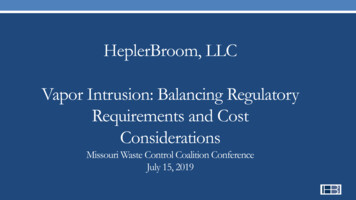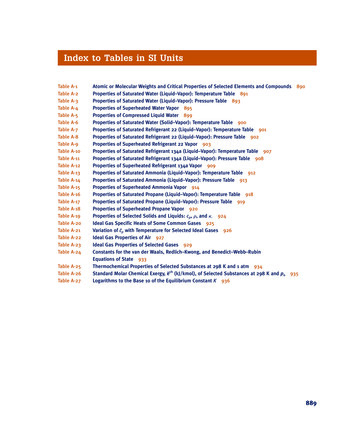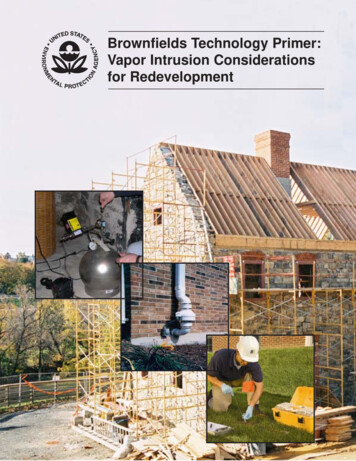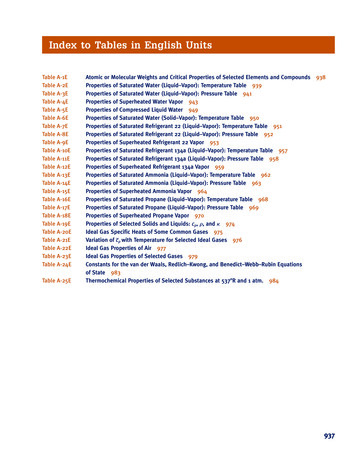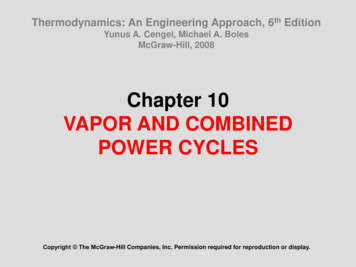
Transcription
Thermodynamics: An Engineering Approach, 6th EditionYunus A. Cengel, Michael A. BolesMcGraw-Hill, 2008Chapter 10VAPOR AND COMBINEDPOWER CYCLESCopyright The McGraw-Hill Companies, Inc. Permission required for reproduction or display.
Objectives Analyze vapor power cycles in which the working fluidis alternately vaporized and condensed. Analyze power generation coupled with processheating called cogeneration. Investigate ways to modify the basic Rankine vaporpower cycle to increase the cycle thermal efficiency. Analyze the reheat and regenerative vapor powercycles. Analyze power cycles that consist of two separatecycles known as combined cycles and binary cycles.2
THE CARNOT VAPOR CYCLEThe Carnot cycle is the most efficient cycle operating between two specified temperaturelimits but it is not a suitable model for power cycles. Because:Process 1-2 Limiting the heat transfer processes to two-phase systems severely limits themaximum temperature that can be used in the cycle (374 C for water)Process 2-3 The turbine cannot handle steam with a high moisture content because of theimpingement of liquid droplets on the turbine blades causing erosion and wear.Process 4-1 It is not practical to design a compressor that handles two phases.The cycle in (b) is not suitable since it requires isentropic compression toextremely high pressures and isothermal heat transfer at variable pressures.1-2 isothermal heataddition in a boiler2-3 isentropic expansionin a turbine3-4 isothermal heatrejection in a condenser4-1 isentropiccompression in acompressorT-s diagram of two Carnot vapor cycles.3
RANKINE CYCLE: THE IDEAL CYCLEFOR VAPOR POWER CYCLESMany of the impracticalities associated with the Carnot cycle can be eliminatedby superheating the steam in the boiler and condensing it completely in thecondenser. The cycle that results is the Rankine cycle, which is the ideal cyclefor vapor power plants. The ideal Rankine cycle does not involve any internalirreversibilities.The simple ideal Rankine cycle.4
Energy Analysis of the Ideal Rankine CycleSteady-flow energy equationThe efficiency of power plants inthe U.S. is often expressed interms of heat rate, which is theamount of heat supplied, in Btu’s,to generate 1 kWh of electricity.The thermal efficiency can be interpretedas the ratio of the area enclosed by thecycle on a T-s diagram to the area underthe heat-addition process.5
DEVIATION OF ACTUAL VAPOR POWERCYCLES FROM IDEALIZED ONESThe actual vapor power cycle differs from the ideal Rankine cycle as aresult of irreversibilities in various components.Fluid friction and heat loss to the surroundings are the two commonsources of irreversibilities.Isentropic efficiencies(a) Deviation of actual vapor power cycle from the ideal Rankine cycle.(b) The effect of pump and turbine irreversibilities on the ideal Rankine cycle.6
HOW CAN WE INCREASE THE EFFICIENCY OF THERANKINE CYCLE?The basic idea behind all the modifications to increase the thermal efficiencyof a power cycle is the same: Increase the average temperature at which heat istransferred to the working fluid in the boiler, or decrease the averagetemperature at which heat is rejected from the working fluid in the condenser.Lowering the Condenser Pressure (Lowers Tlow,avg)To take advantage of the increasedefficiencies at low pressures, the condensersof steam power plants usually operate wellbelow the atmospheric pressure. There is alower limit to this pressure depending on thetemperature of the cooling mediumSide effect: Lowering the condenserpressure increases the moisture content ofthe steam at the final stages of the turbine.The effect of lowering thecondenser pressure on theideal Rankine cycle.7
Superheating the Steam to High Temperatures(Increases Thigh,avg)Both the net work and heat inputincrease as a result of superheatingthe steam to a higher temperature.The overall effect is an increase inthermal efficiency since the averagetemperature at which heat is addedincreases.Superheating to higher temperaturesdecreases the moisture content of thesteam at the turbine exit, which isdesirable.The effect of superheating thesteam to higher temperatureson the ideal Rankine cycle.The temperature is limited bymetallurgical considerations. Presentlythe highest steam temperature allowedat the turbine inlet is about 620 C.8
Increasing the Boiler Pressure (Increases Thigh,avg)For a fixed turbine inlet temperature,the cycle shifts to the left and themoisture content of steam at theturbine exit increases. This sideeffect can be corrected by reheatingthe steam.Today many modern steam powerplants operate at supercriticalpressures (P 22.06 MPa) andhave thermal efficiencies of about40% for fossil-fuel plants and 34%for nuclear plants.The effect of increasing the boilerpressure on the ideal Rankine cycle.A supercritical Rankine cycle.9
THE IDEAL REHEAT RANKINE CYCLEHow can we take advantage of the increased efficiencies at higher boiler pressureswithout facing the problem of excessive moisture at the final stages of the turbine?1. Superheat the steam to very high temperatures. It is limited metallurgically.2. Expand the steam in the turbine in two stages, and reheat it in between (reheat)The ideal reheat Rankine cycle.10
The single reheat in a modern powerplant improves the cycle efficiency by 4 to5% by increasing the averagetemperature at which heat is transferredto the steam.The average temperature during thereheat process can be increased byincreasing the number of expansion andreheat stages. As the number of stages isincreased, the expansion and reheatprocesses approach an isothermalprocess at the maximum temperature.The use of more than two reheat stagesis not practical. The theoreticalimprovement in efficiency from thesecond reheat is about half of that which The average temperature atwhich heat is transferred duringresults from a single reheat.reheating increases as theThe reheat temperatures are very closenumber of reheat stages isor equal to the turbine inlet temperature.increased.The optimum reheat pressure is aboutone-fourth of the maximum cyclepressure.11
THE IDEAL REGENERATIVE RANKINE CYCLEHeat is transferred to the working fluidduring process 2-2’ at a relatively lowtemperature. This lowers the averageheat-addition temperature and thus thecycle efficiency.In steam power plants, steam is extractedfrom the turbine at various points. Thissteam, which could have produced morework by expanding further in the turbine, isused to heat the feedwater instead. Thedevice where the feedwater is heated byregeneration is called a regenerator, or afeedwater heater (FWH).The first part of the heat-additionA feedwater heater is basically a heatprocess in the boiler takes place at exchanger where heat is transferred fromrelatively low temperatures.the steam to the feedwater either bymixing the two fluid streams (openfeedwater heaters) or without mixing them(closed feedwater heaters).12
Open Feedwater HeatersAn open (or direct-contact) feedwaterheater is basically a mixing chamber,where the steam extracted from theturbine mixes with the feedwater exitingthe pump. Ideally, the mixture leavesthe heater as a saturated liquid at theheater pressure.The ideal regenerative Rankine cycle with an open feedwater heater.13
Closed Feedwater HeatersAnother type of feedwater heater frequently used in steam power plants isthe closed feedwater heater, in which heat is transferred from theextracted steam to the feedwater without any mixing taking place. The twostreams now can be at different pressures, since they do not mix.The ideal regenerative Rankine cycle with a closed feedwater heater.14
The closed feedwater heaters are more complex because of the internal tubingnetwork, and thus they are more expensive. Heat transfer in closed feedwaterheaters is less effective since the two streams are not allowed to be in direct contact.However, closed feedwater heaters do not require a separate pump for each heatersince the extracted steam and the feedwater can be at different pressures.A steam power plant with one openand three closed feedwater heaters.Open feedwaterheaters are simpleand inexpensiveand have goodheat transfercharacteristics. Foreach heater,however, a pump isrequired to handlethe feedwater.Most steam powerplants use acombination ofopen and closedfeedwater heaters.15
SECOND-LAW ANALYSIS OF VAPORPOWER CYCLESExergy destruction for a steady-flow systemSteady-flow, oneinlet, one-exitExergy destruction of a cycleFor a cycle with heat transferonly with a source and a sinkStream exergyA second-law analysis of vaporpower cycles reveals where thelargest irreversibilities occur and where to start improvements.16
COGENERATIONMany industries require energy input in the form of heat, called processheat. Process heat in these industries is usually supplied by steam at 5 to7 atm and 150 to 200 C. Energy is usually transferred to the steam byburning coal, oil, natural gas, or another fuel in a furnace.Industries that use large amountsof process heat also consume alarge amount of electric power.It makes sense to use the alreadyexisting work potential to producepower instead of letting it go towaste.The result is a plant that produceselectricity while meeting theprocess-heat requirements ofcertain industrial processes(cogeneration plant)A simple process-heating plant.Cogeneration: The production of more than one useful form of energy(such as process heat and electric power) from the same energy source.17
Utilizationfactor The utilization factor of theideal steam-turbinecogeneration plant is100%. Actual cogeneration plantshave utilization factors ashigh as 80%.An ideal cogeneration plant. Some recent cogenerationplants have even higherutilization factors.18
At times of high demand for process heat, allthe steam is routed to the process-heating unitsand none to the condenser (m7 0). The wasteheat is zero in this mode.If this is not sufficient, some steam leaving theboiler is throttled by an expansion or pressurereducing valve to the extraction pressure P6and is directed to the process-heating unit.Maximum process heating is realized when allthe steam leaving the boiler passes through thePRV (m5 m4). No power is produced in thismode.When there is no demand for process heat, allthe steam passes through the turbine and thecondenser (m5 m6 0), and the cogenerationplant operates as an ordinary steam powerplant.A cogeneration plant withadjustable loads.19
COMBINED GAS–VAPOR POWER CYCLES The continued quest for higher thermal efficiencies has resulted in ratherinnovative modifications to conventional power plants. A popular modification involves a gas power cycle topping a vapor power cycle,which is called the combined gas–vapor cycle, or just the combined cycle. The combined cycle of greatest interest is the gas-turbine (Brayton) cycle toppinga steam-turbine (Rankine) cycle, which has a higher thermal efficiency thaneither of the cycles executed individually. It makes engineering sense to take advantage of the very desirablecharacteristics of the gas-turbine cycle at high temperatures and to use the hightemperature exhaust gases as the energy source for the bottoming cycle such asa steam power cycle. The result is a combined gas–steam cycle. Recent developments in gas-turbine technology have made the combined gas–steam cycle economically very attractive. The combined cycle increases the efficiency without increasing the initial costgreatly. Consequently, many new power plants operate on combined cycles, andmany more existing steam- or gas-turbine plants are being converted tocombined-cycle power plants. Thermal efficiencies over 50% are reported.20
Combined gas–steam power plant.21
Summary The Carnot vapor cycle Rankine cycle: The ideal cycle for vapor power cycles Energy analysis of the ideal Rankine cycle Deviation of actual vapor power cycles from idealized ones How can we increase the efficiency of the Rankine cycle? Lowering the condenser pressure (Lowers Tlow,avg) Superheating the steam to high temperatures (Increases Thigh,avg) Increasing the boiler pressure (Increases Thigh,avg) The ideal reheat Rankine cycle The ideal regenerative Rankine cycle Open feedwater heaters Closed feedwater heaters Second-law analysis of vapor power cycles Cogeneration Combined gas–vapor power cycles22
Analyze vapor power cycles in which the working fluid is alternately vaporized and condensed. Analyze power generation coupled with process heating called cogeneration. Investigate ways to modify the basic Rankine vapor power cycle to increase the cycle thermal efficiency. Analyze the reheat and regenerative vapor power cycles.



